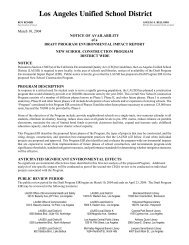Site-Specific Health and Safety Plan (HASP) - Laschools.org
Site-Specific Health and Safety Plan (HASP) - Laschools.org
Site-Specific Health and Safety Plan (HASP) - Laschools.org
You also want an ePaper? Increase the reach of your titles
YUMPU automatically turns print PDFs into web optimized ePapers that Google loves.
APPENDIX A<br />
COLUMN TEST FOR DETERMINING SORBED HEXAVALENT CHROMIUM<br />
Heavy concentrations of hexavalent chromium have been found on one of the parcels of<br />
the Los Angeles Unified School District site in South Gate. In order to determine<br />
potential approaches to clean up the site it is necessary to know whether the hexavalent<br />
chromium is present only in the dissolved form in the groundwater or it is also sorbed on<br />
soil particles. If the hexavalent chromium is present in the sorbed form, its presence<br />
could potentially be of much greater duration.<br />
In the saturated zone water is present both free flowing among the solid particles <strong>and</strong> in<br />
pores <strong>and</strong> cavities within the particles. Thus, when the sample of soil is filtered, a<br />
significant amount of the hexavalent chromium may still be present as dissolved<br />
hexavalent chromium. The dissolved hexavalent chromium in the pores contains the<br />
same concentration of hexavalent chromium as the groundwater. In order to assess<br />
whether all the hexavalent chromium is dissolved or some of it is adsorbed, it is<br />
necessary to leach all the hexavalent chromium out of the soil. In so doing the dissolved<br />
hexavalent chromium will leach out first, followed by the sorbed material.<br />
The testing to determine if a significant amount of hexavalent chromium is present as<br />
dissolved material consists of determining if the total amount of hexavalent chromium<br />
recoverable from the soil exceeds the amount which would be present in the water<br />
retained by the soil.<br />
Procedure<br />
1. Collect a sample of saturated zone soil <strong>and</strong> a sample of the groundwater<br />
preferably from the same boring <strong>and</strong> at the same depth. Both samples must be<br />
taken from a location known to contain hexavalent chromium.<br />
2. Filter the groundwater <strong>and</strong> determine the concentration of hexavalent<br />
chromium in the groundwater.<br />
3. Take a 1 – 5 gram sample of the soil <strong>and</strong> place it in a tared glass dish to<br />
determine the water content of the soil. Weigh the dish with the sample <strong>and</strong><br />
subtract the weight of the dish to determine the exact weight (W1) of the<br />
sample. Do not use aluminum pans because hexavalent chromium, if present<br />
in significant concentrations in the soil, will corrode the aluminum.<br />
4. Dry the soil at 100 – 105 o C to constant weight. Determine the weight of the<br />
dry sample (W2) by subtracting the weight of the dish from the weight of the<br />
dish with the dry sample.<br />
5. Determine the weight of the water in the sample by subtracting the dry weight<br />
of the sample from the wet weight of the sample (W1 – W2). If one assumes a<br />
341







